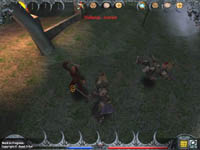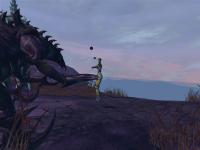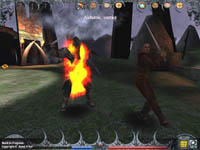| |
Site Navigation
Main
News
Forums
Games
Games Database
Top 100
Release List
Support Files
Features
Reviews
Previews
Interviews
Editorials
Diaries
Misc
Download
Gallery
Music
Screenshots
Videos
Miscellaneous
Staff Members
Privacy Statement
|
|
by Garrett,
2002-08-22
Mistmare is another interesting new RPG by Sinister Systems, published by Arxel Tribe. It takes place in an alternate Europe in the year 1996; this quite unusual setting is explained more thouroughly by Sinister Systems' Lead Level Designer "Primvla":

RPGDot: The setting for Mistmare is quite unusual, but nevertheless extremely interesting: I quote the setting from the webpage for those who don't know about it:
"The year is 1996 and the world is different, there was no industrial revolution, there are no cars or mobile phones, there is only the feeble existence of people who have to fight the land, that decided it would fight back. The world is in turmoil and large parts of the continent are covered in thick mist with magical properties that forbids the passage through central Europe. Join Isador as he explores the world, searching for the man, deemed by the Church to be a murderer and an antichrist. The once great cities will pass you by: Rome, Avignon, Paris and others; on your quest to stop this man."
How do we have to imagine this world? Is it more medieval or apocalyptic or totally different?
Primvla: The most radical change in Mistmare Europe is a large cloud of magical Fog, which has started to appear after the Roman Church used its newly acquired magical powers and a magical-enhancing device called the Controlling Ring, to banish the incoming disease in early 14th century. The Fog has enveloped central Europe and no one who went into it was seen again. It's completely dividing Europe into North and South which means no communications between these parts for 600 years. The cloud also disables navigation on the seas around that part of the world and Fog reaches far into Atlantic ocean.
Southern Europe (Holy Roman Republic) is isolated: to the north, the Fog prohibits passage; no ships that sail through the Straits of Gibraltar on the west ever returned. The mighty Moslem empire, which also spans the southern end of Spain, prohibits the passage to the south and to the east. Towns that border the Fog are protected by harmonic tolling, a liturgical magical spell using magically crafted church bells. South has put all efforts in researching lithurgical magic to defend the land from Fog. All other sciences are classical. No technological development, enlightened feudalism under conrtrol of the Church instead.
North (Scandinavia) on the other hand developed greatly in industrial sciences (although magical!) but due to constant threat and struggle against Fog they couldn't develop beyond keeping a status quo, same as South did. They fight fog with repelling crystals and magic is more of alchemical type (aclhemist barons control the land under the rule of the King and optional conflicts between them are not rare).
In between North and South there are some enclave cities which somehow managed to use certain defences against Fog and keep their population in numbers large enough to survive through these centuries.
So the atmosphere in cities is Medieval, with a touch of industry and science fiction in some parts.
In the Fog, there is no place for a human or any other being with a place for fear in consciousness; the land in Fog isn't apocalyptic, it's more surreal - with menacing monsters of course. A place for only a hero to survive.
 |
RPGDot: We are travelling with this Isador - Is he controlled by us as well like in a party or is he more of an NPC? Is there a party or can we recruit other NPCs?
Primvla: Isador (the Inquisitor) is the main character of the game. He is controlled by the player most similar to Christoph in Vampire the Masquerade: point and click movement, 3rd person camera. As for the combat, some AI takes precedence over control of the movement and strikes.
Player won't be able to recruit other NPCs into the party except in certain scripted situations, and even then, without control over them.
But there is a number of monsters that Isador can trap into the crystals and release and control them later, so we can say it's about a party concept there. Combat with trapped creatures will subsequentially look more like some (simple, tactical) RTS with elements such as: move a controlled monster onto selected ground location, choose its target, fall back into formation.
RPGDot: I understand we travel Rome or Paris for example - what other places can we go to?
Primvla: Game starts in Spain and Greece for tutorial and the story itself starts in Rome. We visit Avignon, which is still part of the Holy Roman Republic. Later we go through isolated enclavas Paris and Antwerpen. Before reaching the objective in Scandinavia, we make a visit to Anglia. All these parts beautifully rendered in 3d levels, made by our experienced artists.
!!!: But most of them places we want to keep in secret for players to enjoy the excitement when reaching, so I rather keep the interview not so revealing in this area (story and places).
RPGDot: I want to move on to the gameplay now: Can you describe it please? Is the emphasis on story and quests or more on hacking and fighting?
Primvla: Mistmare is also an adventure game which means strong story. But it's an RPG, which means loads of items with all kinds of statistics, building points on many interesting and versatile places (or props), interesting sidequests and also combat arenas for hack&slash fans (many of them are just optional - as building points!). Most of RPG is integrated in storyline (into interaction with the world); there is no distribution of experience points by clicking "+" buttons in GUI.
Time (NOT real time with pushing players to almost arcade elements!) is very important as a resource in the game. Every episode has certain amount of time to complete (most of storyline actions are set to consume no time or time that is "guaranteed", so you can't get stuck this way in storyline; but you can get short in time for sidequests and building points if you don't play smart) and some bonus time which player can use for building whenever needed. Bonus time can be gained or lost (resource).
Player trades time for statistics (and money; if he assists blacksmith for instance). All interactions take time and reward is in context with the situation:
lockpicking a chest will take time and give some proficiencies in lockpicking skill, besides the content of the chest for instance
fighting a tough enemy using certain combat or magic school will improve character's proficiencies in that school
praying at the "strength shrine" takes time and gives strength (if you want to get control over basic stats for instance)
sidequest obstacles take time and give nice quest rewards
player loses combat and trades one bonus day for recovery (or in lack of latter: dynamic game level decreases and obstacles (opponents) get less tougher, player can overcome them but gets lesser reward; so you can't get stuck that way either)
...
RPGDot: Is there a character generation? And is there a real RPG System behind Mistmare or just a handful of attributes like strength and dexterity, to name some of the most common?
Primvla: We planned some basic character generation in the playable tutorial (episode 0). Main character still remains Isador, but player can choose more spiritual (lithurgical sorcerer) or more corporeal (warrior) way and have also some control over basic stats distribution in tutorial episode.
There is a fat RPG system behind Mistmare and a very lightweight frontend for the players. There is a handful of basic attributes, a handful of skills, spells and combat schools. And the items have a handful of stats and opponents have handful of stats and EVERYTHING is interconnected, so in the end we (not the player) end up with a large sum of 'handfuls' with many equations to calculate needed results for the situations in the game. Relations, presented for the player, on the other hand, should be quite intuitive and simple.
And for the enthusiasts we plan to publish rulebook soon at the Mistmare web page.
RPGDot: Is there magic or something similar as well and if so, how does it work?
Primvla: There is a spell system within the RPG system. There are enhancement and aggresive spells. Some spells modify stats, have special effects like 'shrink' or 'convert' in their higher levels, but most of the basic spell effects fall into the easy-to-understand system of schools and spheres. We wanted to make the system in a such way that none of the spells would become obsolete and I think we kinda succeded in that. There are only few spells but they can be cast in three different spheres and in four incremental effects (basic effect for the beginners, effect +, effect ++ and for those who are really proficient also some special effect on the top of all that the spell effect group in a single cast).
Some items may also have magic effects (weapons and armours) within the system and special or exotic items may also have some extra scripted magical (and visual of course) effects. And many opponents should wield magic. Lithurgical in south, alchemical in North and wilderness magic by beasts and maybe the Druids in Anglia (episode 5).
So we think the magical part is well covered here.
RPGDot: What else does the game offer? A journal, a quest book, automap, a real inventory, multiple choice dialogues, etc...?
Primvla: There is no RPG (in a classical sense) without questlog and journal. Journal covers all relevant events in the game (in no predefined order) and quest log keeps record of open and finished quests.
With a variety and quantity of items in the game the inventory is one of the essential parts of the user interface, with many groups of items, item interactivity and detail description of each.
There is no automap and maps are not interactive. You buy or get a map of the city and it's only an image. However, map is one of the four main parts of the GUI (charsheet, questlog, map, inventory) and as items, some maps could be obtained through sidequests as secrets to gain access to other, even more secret places, and there to find maps of even more secret location... Ok.
Game has a multiple choice dialogue system, not only for the puropse of cosmetics, but also because character development is not only manageable through RPG system, but also through dialogues. We wanted to keep character development covered in storytelling sense, too ("attitude" stats such as: individuality, selfishness,…). And the storyline runs mainly through dialogues (hence the wordcount of about 120.000).
Etc...? The most important weapon in the game can be managed through interface, crystals can be inserted and later on, in the battle, creatures can be captured into crystals, released and controlled through that interface. This weapon can be improved by blacksmiths, scientists or even certain institutes (khm,… almost said too much) and Monster statistics and special effects on them can be built according to attributes of the crystals in which they are trapped to. It's a summoning game, too.
 |
RPGDot: Is there a multiplayer part and if so, what gamemodes does it offer? Will there be dedicated servers by Arxel Tribe?
Primvla: There is no multiplayer planned for the release for now. Logical game engine is already multiplayer compatible and we have some multiplayer modes already in prepare (coop scenarios, deathmatch arenas, dungeon keeper like mode (non-summoner characters against summoner), multiplayer RTS mode (DM of summoners), saving character, keeping info on internet,…).
It's on Arxel to decide to go multiplayer and on us, sinsys, to script those modes (which shouldn't take much time).
RPGDot: When do you expect Mistmare to be ready for shelves? Will there be a playable demo?
Primvla: Development team has released many versions of the game (playable demos) already. It's on the marketing team to decide which version and timing is good enough for the worldwide distribution.
Expected date of final release is still Q4 2002.
|
|







